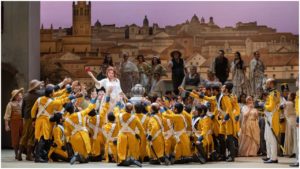
Royal Opera House Muscat 2019-20 Review: Carmen
Buoyed By Vibrant Artists, Gianni Quaranta’s Production is Glorious To Behold
By David Salazar(Photo credit: Khalid AlBusaidi / ROHM)
This review is for performances on Sept. 11 and 14, 2019.
Writing a review after an initial performance of any run is a challenging proposition. You are essentially recording your views on a first impression without really getting a chance to see the full picture. There are many reasons why this is the case, but in taking on some productions, it is truly possible to get a more panoramic view of a production and its development to fully understand the artistic intentions.
This was undeniably the case with the Royal Opera House Muscat’s production of Bizet’s “Carmen,” which opened on Sept. 11, 2019 and featured two subsequent performances over three nights. OperaWire saw the opening and closing night shows, which were completely different in how they told the story.
The production, a revival of Gianni Quaranta’s vision, is a visual spectacle that rivals the imperious opera house itself and its own imposing elegance and vibrancy. Quaranta’s set design is Zeffirelli-esque in its incredible detail, immersive nature, and adherence to a traditional approach to the French opera.
Glorious Hyper-Realism
As audiences entered the hall, the stage represented the outside of a bullring with three archways in the center. During the overture, a few towns people, dressed in Spanish garb of the 1800s would walk to and fro. Immediately, this established the world of the story, but also emphasized the motif of the bullring as central to the story. It also teased the opera’s final scene in which José and Carmen’s fateful confrontation would take place in the exact place where the opera started.
The bullring would then open up to reveal the distinct locations of the four acts, each opening frame an assault on the senses, in the best of ways. For Act one, we got to see the town square, with a glorious backdrop that rendered the town expanding into the distance. In Act two, Lillas Pastias’ Inn was rendered gloriously with chiaroscuro lighting. Perhaps the most incredible image to materialize when the bullring parted was the two level mountains of Act three with caves and alcoves embedded to create a sense of increased claustrophobia. Set against blue lighting, the coldness of this environment only furthered the increased distance between Carmen and José. Finally, Act four opened up to the inside of the bull ring itself with a massive chorus seated all over. The parade itself entered, with horses from the Omani Sultan’s own stable joining in, adding to the sense of spectacle and hyper-realism at hand; the varied color of the distinct wardrobes added to this overwhelming experience.
The set then closed up again for the final confrontation, emphasizing the circular nature of the story.
Quaranta, who famously designed the set for the Met Opera’s recent “Aida” production, also designed the costumes for this production and his ready attention to detail adds to the level of immersion. You feel that you are truly glimpsing into that period.
On a purely visual level, this production is what everyone dreams of when they refer to what “Carmen” is SUPPOSED to look like. Some might find this reductive in imagination, but the reality is that Quaranta, who directed the production, manages to showcase some truly mesmerizing stagecraft as well.
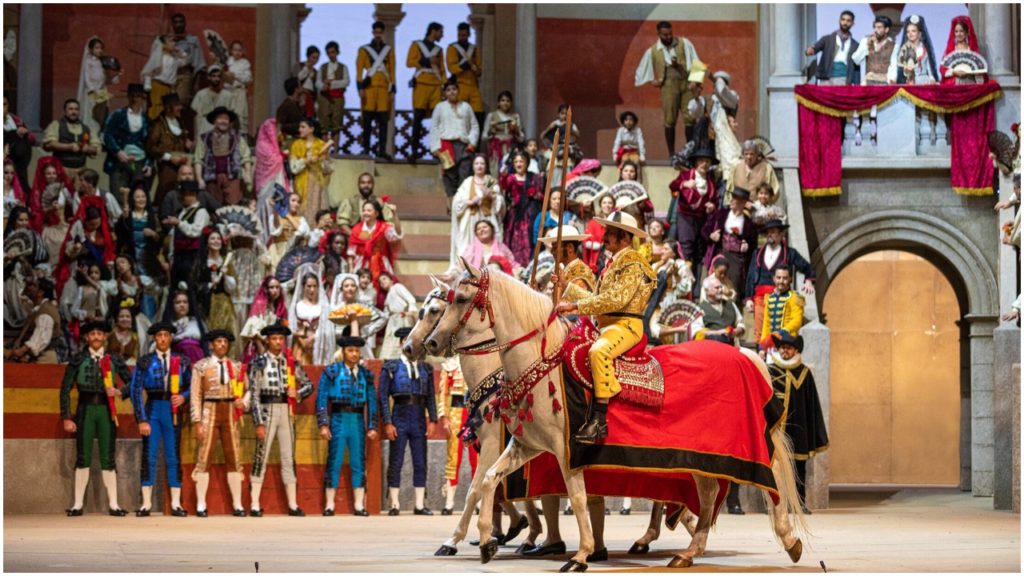
(Photo credit: Khalid AlBusaidi / ROHM)
Attention to Detail
The chorus was alive throughout. One glance at anyone onstage and you immediately got a sense of a clarity of character and goals. Whether it be men and women flirting or antagonizing one another in Act one, or getting into rhythm for the dances during the gypsy dance of Act two, or simply creating the atmosphere and energy of Act four’s opening, everyone was locked in.
One of the common challenges of productions that approach the work from a traditional perspective is that many often feel static; one gets the feeling that singers are weighed down by costumes and scenery, with the singing being called on to do the heavy lifting. Often that is not enough.
But Quaranta kept the production alive constantly with the relationships and characters often locked into one another. One such example would be the Act five quintet which is often a staging tirefire with singers moving around aimless or resorting to silly antics to keep the passage alive. Someone like Barrie Kosky turned it into a choreographed vaudeville number, but Quaranta opts for spacial dynamics to tell the story. The five sit together at a table to commence the ensemble, letting their respective interactions with one another guide the way. Eventually Carmen gets up and moves away from the group; the two men follow her and challenge her rather physically to give in. When she talks about being in love, Dancaïre’s retort that this is nothing new is furthered by him looking at her viciously and even putting his hand all over her. From this subtle interaction and her returned glance at him, a sly smile, it was suggested that something happened between the two of them and that perhaps there was some resentment there. Eventually, the quintet returned to its initial musical gesture and the five returned to their very spots at the table. The entire stagecraft not only mirrored and reflected on the musical structure, but its return to its initial stasis emphasized the scene itself not accomplishing any shift in the characters’ respective positions.
The choice of having the final duet take place in a very narrow strip of the stage, with the two characters perilously close to the pit, only added to the sense of tension throughout the big confrontation.
Again, this attention to detail kept the work alive and allowed unique insight into character relationships (much more later).
Some Pitfalls & Awkwardness
But of course, not all of the brilliant stage craft worked. In fact, when Quaranta went for his biggest ideas, his vision seemed to lose its strength.
Having a full-on flamenco dance during the gypsy dance was great in theory and matched the visual spectacle, but it was not practical for the music as the dancers not only managed to overpower mezzo-soprano Elena Maximova, but somehow did the same to the orchestra (which mind you, is no easy feat in a theater that so clearly favors the ensemble in the pit).
The same could be said about the business with women fighting amongst themselves for Escamillo during “A votre toast.” The first time they got at each other, you could let it slide. But it repeated itself throughout the aria, coming off as distracting and ultimately, not adding much to the story or overall scene. The fact that the conflict itself had no real resolution, made it seem empty.
Then there are also a number of dancers jumping gracefully over tables as they “cleaned.” It seemed a bit much after a full-on flamenco dance number and detracted from the overall sense of realism that the production showcased.
But perhaps, in one of the most awkward opera moments of recent memory, the children’s chorus was sung by women offstage, with the kids doing strange lip-synching jobs. Obviously the children are doing what they can and what they are told, and the chorus is also doing what is needed, but the cognitive dissonance of this particular moment undercut the realism being attempted in the production and probably should have been cut out altogether if there was no children’s chorus on hand.
Another moment that went against the overall realistic style was the closing of the bullring in Act four. Carmen went from being inside the bullring to suddenly being outside of it. Suspension of disbelief makes sense physically and geographically, but narratively it is off base. Why does Carmen leave the inside of the stadium when her sole purpose of being there is to see Escamillo bull fight? And to that point, why do her cohorts, Mercédès and Frasquita let her exit the Ring, especially if they spotted Don José inside with the crowd of people? This particular choice seemed like a director choosing the visual splendor over narrative fluency and logic.
The Tragedy of Don José
But the most questionable aspect of the production was the narrative shift to portraying the opera globally as the tragedy of Don José.
As the overture shifts to the Andante moderato in A minor, a man limps on stage, seemingly running away from some oncoming attacker. As he nearly makes his way from stage left to right, his attacker reveals himself – Don José. The opera’s tragic hero suddenly runs across the stage, behind the columns and stabs the man. The overture comes to an end with that image, suddenly transforming the entire story and subverting audience expectations in a truly uncomfortable way.
Per Quaranta’s program notes, José is wanted for this murder and thus enlists in the army to redeem himself and show himself to be a man of honor. As such, the opera’s formal narrative becomes, as Quaranta notes, “a drama about the impossibility of escaping one’s temperament.”
We get closer looks at José’s monstrous behavior as he impulsively kills Zuñiga at the end of Act two and abuses Carmen right from the start of their reunion in Act two; his famed aria “La fleur que tu m’avais jetée” is not a declaration of love but an apology after having grabbed Carmen and thrown her violently to the floor. It only goes downhill from there.
A dark vision of José is in and of itself not problematic, especially in the #metoo mileu.
Tenor José Cura, who interpreted the character, noted in conversation that he sees José’s love for Carmen as nothing more than sexual awakening for a teenager and that his possession arises not from a sense of love, but machismo insecurity. Quaranta’s argument, also expressed in conversation, furthers this assessment of José as an exploration of a social attitude, noting that the character’s murderous tendencies needed to come from somewhere and as depicted in the opera, it is hard to believe that a man of virtue could stoop so low without antecedents of such behavior. Furthermore, by being forgiven for his crime, he was being supported by the social structure. Finally, he pointed to Merimée’s darker vision of the character in the original novella.
And this is all well and fine, but it comes at a cost – Carmen.
Any potential “love” between them does not exist in this production. The opera itself doesn’t present many chances for creating a credible sense of connection between the two and the choices here only furthered the audience from any such notion. Quaranta has explained that Omani regulations forbid that he have the characters engage in any suggestive behavior, with even kissing completely off limits. This undeniably hindered this aspect of the production, but with no other workaround, the result only emphasizes the emotional void between the two; the choice to make physical abuse the defining aspect of the relationship only exacerbates it. So one ends up asking why she even bothers with him in the first place?
The story thus turns Carmen into someone that keeps coming back for more, even though she knows that she can’t control the guy and that he’s just going to keep doing the same thing again and again. One might argue that the entire final duet in this production happens because she goes looking for a rendez-vous with José and that’s why she leaves the stadium. Furthermore, her understanding of his abuse comes to a head when Carmen even toys with those limits and her understanding of them. When he points the dagger toward her, she laughs in his face, suggesting that she knows he won’t do it; he’s done the same thing in Act three and wouldn’t go further. He bullied her in Act two and then apologized. So when he does stab her, she’s surprised by his action. She wasn’t ready to die and now the system of control and violence has finally destroyed her.
And yet, she doesn’t end up the tragic heroine of the piece. He does.
Despite the depictions of her as a victim at the hands of a monstrous society, she is but a pawn in the hands of a greater fate that made the monster realize that he will always be subject to his unchanging nature no matter how hard he tries to get away from it. As at the beginning of the story, José was destined to kill again and it could have been anyone. And he might do it again in that very machista society. Carmen, in the larger narrative of Don José’s tragedy as depicted in this production, is as much a footnote in his life as the anonymous man he murdered at the opera’s beginning.
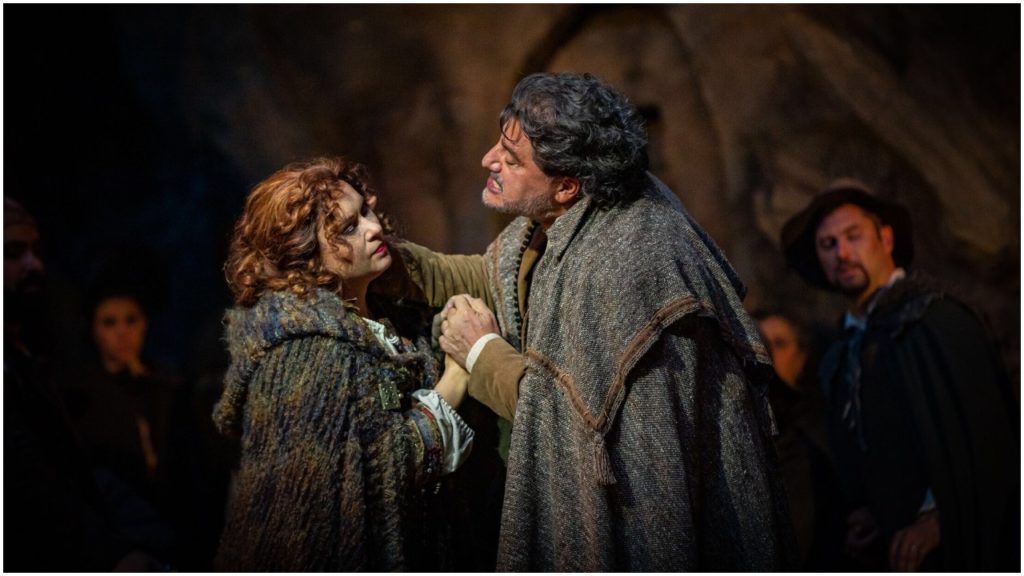
(Photo credit: Khalid AlBusaidi / ROHM)
Violent Vocal Acting
The opera’s main cast handled the challenges of this production rather well with Cura likely the standout on stage. During the habanera he maintained a sense of isolation, keeping his distance as best as he can. At one point, with her staring him down during the Habanera, he unsheathed his sword, a subtle suggestion to keep away from him. But when she threw the flower in his direction, something changed in him. He stood frozen in his place, his back to the audience. And yet you could sense the energy shifting around him. As people left the stage, his frozen position suggested some internal turmoil unspooling from the character.
And this is where the performance across both nights diverged most readily. On opening night, Cura was distant and a bit removed from Micaëla during their duet. But on the closing evening, he was more open emotionally to her, even looking on affectionately and staring into her eyes, creating a beautiful connection at the close of the duet. As such, opening night would be defined by a more socially awkward and violent José with the closing performance hinting at his more tender side.
With this particular opera, the tenor himself noted that he has more interested in exploring the emotional essence of José as a character, instead of falling into the trap of letting the deceptive nature of Bizet’s lush and romantic melodies take the lead. To that end, Cura’s voice is more an instrument for characterization instead of an instrument in and of itself. So we get harsher vocalization and phrasing, not always aesthetically pleasing in the traditional sense, that is furthered by the cruder colors of his Argentine tenor.
So with such moments as the end of Act one, José’s line “Je suis un homme ivre,” which signaled a loss of his control and the next phase of his fall, was jagged and increasingly forceful, the high A sharp pushed with all its might. During the opening performance, Cura’s top notes had a frayed vibrato, but as the night went on, the squillo in the upper range was more controlled and poised. On the closing night, the squillo on the highs, despite some inconsistent intonation, was often solidly placed and resonant throughout the night.
“La fleur” was affecting in unexpected ways. After having thrown Carmen down to the floor violently in an equally aggressive vocal display, the tenor walked away from her and sat on the table, his body closing up in shame. In this position, he sang the aria with very quiet and gentle tone, each phrase but a whisper. Opening night featured some unevenness of phrasing and inconsistent intonation with some of the lower notes coming off as accents next to the gentler middle line, but the effect was involving nonetheless; on closing night, the line was immaculate and beautifully constructed vocally. The aria, on both nights, became an apology and a character tending to a wound at the same time, with Cura increasingly ramping up the intensity throughout. The closing night performance featured a breathtaking crescendo on “un seul desire, un seule espoir” to the high A flat. The high B flat at the climax was delivered forte (and absolutely enthralling on the final show) with the ensuing “Carmen, je t’aime” sung with a glorious pianissimo diminuendo.
Cura’s third and fourth act performance on opening night were his strongest by far, with closing night’s final Act perhaps even more intense in many ways. During the first performance, he unleashed the violence. There is nothing quite like the intensity emanating from Cura’s eyes as he grabbed Carmen and blasted out the passages “Tu me dis de la suivre” and “Je te tiens fille damnée” with increased passion. It was frightening to witness, the physical power furthered by the voice’s own dagger-like phrasing and forceful enunciation; it was quite surprising to see the third Act of the closing night lacking somewhat in this passion, which was one reason why, on that night, Act three was the least effective (it was the most impactful on opening night).
While he had moments of gentle and tender singing in the fourth Act, Cura’s José snapped quite quickly and kept pushing himself further and further physically and vocally as the passage developed. His big “Pour la dernier foi” was the breaking point with the tenor leaning against the wall in frustration, before propping himself up, turning to Carmen and suddenly transforming into a monster in his physicality and glare. The high B flat on “Démon” was violent in its attack and the following text and musical line were crazed in delivery and execution.
And despite Cura creating this sense of inevitability about José the entire night, he managed to express his tragedy in one very telling moment. Carmen stood right in his face, readying herself for him to kill her. He had his knife at the ready and then he stopped himself. He backed away, confused, and seemingly locked in internal battle with himself. It is when she laughed at him that he suddenly felt that he wouldn’t let her win. It was then, at the smallest of humiliations (albeit a public one), that the tragedy of José expressed itself and he murdered her.
On closing night, the entire staging was changed with the two artists further apart on stage and Cura begging instead of imposing. It reflected more of a character desperate for love than a possessive macho.
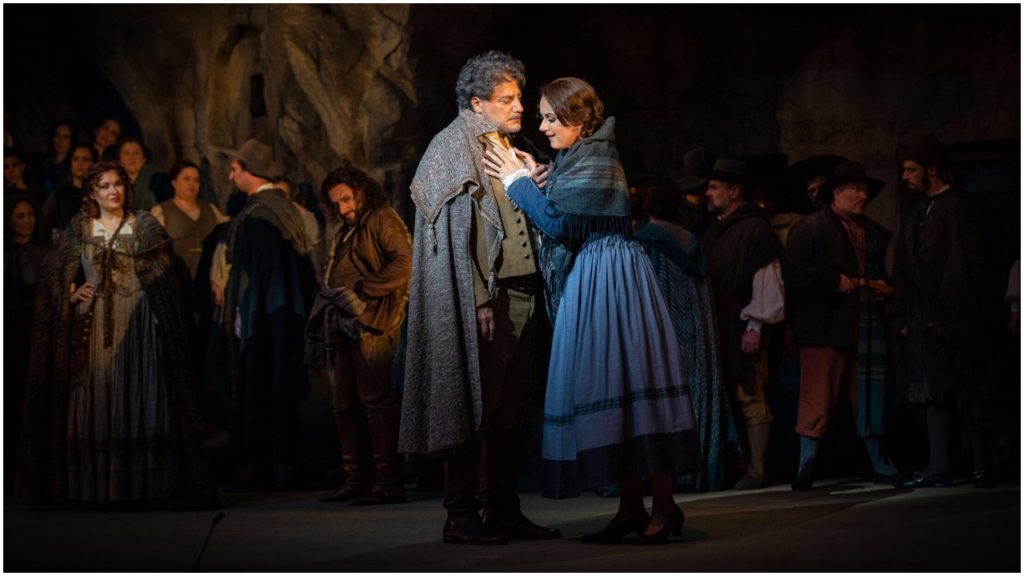
(Photo credit: Khalid AlBusaidi / ROHM)
Vocal Beauty & Blandness
Anita Hartig also delivered an astonishing performance, though hers was undeniably the result of vocal beauty and vibrancy. More than anyone else, she spun a glorious line every time she stepped onstage.
The aria in Act three, of course, is the big moment for any soprano taking on the role and few today have the expansiveness of line that Hartig displays here. Starting with gentle piano phrasing that immediately draws the listener in, she connected every note beautifully, shaping the line to the most subtle of crescendoes up to the F sharp and G natural on “Mais, j’ai beau…” From there she made a beautiful portamento down an octave and rebuilt the line until the climactic G natural on peur that she then crescendoed into the next line, all on the same breath. The Allegro molto moderato section features a more imposing vocal line and Hartig used it to emphasize a sense of assertion for Micaëla, her G naturals pouring out into the theater firmly, but without ever losing their beauty and richness. The same goes for the high B natural of the passage; again, Hartig built the entire passage expertly to anticipate the climax musically and emotionally and then paid it off with her glorious voice. The repetition of the aria’s main melody was crafted just as beautifully, though Hartig managed to find even greater intensity and crescendo on the G of “peur” before slowly relaxing into the final “seigneur” of the aria. There was a true sense of shape in the overall emotional form of the aria that highlighted the powerful vocal artistry of Hartig.
And yet her most effective moment of the Act came at its close when she rushed in to stop José’s abuse of Carmen. In some ways, her assertiveness as she demanded “une parole encore” came off as heroic, her voice soaring in over the chorus as she also freed Carmen from José’s grasp. She was confronting him in a low point, and for one moment, you could sense that he was regaining some degree of control over himself. Of course he didn’t, but even then, there was display of affection on her part as they walked away.
The final image of the Act is Carmen at the bottom of the two levels fearing for her future. At the top are Micaëla and José, in silhouette, the former holding the latter’s head in a nurturing and motherly way. It created a feeling of Micaëla potentially being a savior in José’s life and suggests that his inability to follow her fully as being a catalyst for his downfall.
It must be noted that vocally Hartig seemed a bit more subdued on the closing night performance and somehow her reaction in the third Act to Carmen’s abuse seemed delayed; again, that entire Act didn’t quite work overall in the way it had the first evening.
If there was one consistent factor across both evenings, it was baritone George Petean. And that consistency was a double-edged sword.
On one hand, he delivered quite well vocally overall. He stood out most in “A votre toast,” particularly in the high notes where he shined. The challenge with this aria is that it demands an expansive range that is often too high for a bass or bass-baritone, but too low for a baritone. Being a baritone, Petean understandably garbled some of the lows and at times simply sang them with breathy piano and moved on. He paired his voice with that of Elena Maximova’s well in the final act, suggesting the vocal match between Carmen and Escamillo.
But unfortunately, he brought little in the way of characterization and charisma, often just parking and barking. He was nowhere near the valiant and exciting bullfighter that the opera suggests and this was only exacerbated by the fact that the duel with José was cut completely from the score He thus stood out (in the wrong way) in the busy and lively production.
A Troubled Carmen Redeems Herself
Had I only reviewed opening night, Elena Maximova would have been the skewered in this section as she was the definition of inconsistent and lost. Her Carmen was a victim, afraid of José and with little agency to assert herself. Thus, her tragedy was not that of a woman fighting for her freedom, but one who let herself be abused.
Moreover, Maximova’s voice was sloppy throughout and from the get-go, her voice struggled to project in the hall and her middle and lows seemed stuck in her throat. The middle voice had a nasal quality and the highs were shrill and often sharp in pitch. This was most evident in the habanera and seguidille, with the coloratura runs of the latter all over the place. Her dance with castanets was defined by uneven phrasing on the “la la’s” with the voice shifting from guttural to nasal sounds throughout.
Fortunately, I got a second chance to see her in the final performance and she was a different performer in many respects. Of course, her vocalization was not going to change radically and she still had the guttural qualities in the lows and the nasal in the middle, with many high notes still sharp and shrill. But those imperfections were matched with a tremendous vocal confidence that not only elevated her singing, but her ability to define Carmen as a true woman of power and liberty in the face of male oppression. As such, she didn’t become a passive character, but ignited the drama, particularly in the final act.
The habanera and seguidille were seductive not because she was overly sexual (Omani regulations got in the way), but because of how she stared at José and the other men sang with poise and freedom. The habanera felt fresh and alive with strong legato phrasing and careful textual emphasis. The seguidille was riveting in its sense of direction and clean coloratura runs. And the castanets dance was rich in colors and fluidity with the lines polished as they moved up and down; she managed to mix in some glorious piano singing that added to the seductiveness of her interpretation.
She really shined in Act three on both nights, particularly with the famed card aria, building a solid flowing legato line to the climax of the entire passage on an F natural; while the note itself was a bit frayed in pitch, the way she built to it was exciting and intense, mirroring the sense of dread and urgency Carmen was enduring. Moreover, the repeats of “Encore” on an F flat and E flat were increasingly aggressive, ending with a bitter and darkly shaded “Toujours la mort.” It was her strongest singing on the night. She also rounded into vocal form in the fourth Act, especially on the second night where her sound was round and gleamed in every exchange with José. Cura’s voice would blast sound in her direction and she would response with increasingly rounded vocalization.
The only passage that consistently problematic over the two nights was the gypsy song. Though Maximova brought great energy to the famed passage, she was often lost in the tumult and didn’t quite make a mark. The tempi started off very slowly. The score reads Andantino quasi Allegretto, but it sounded more like Andante. The intention was to build the tempo bit by bit to a speedy climax. Of course, the challenge is that it forced Maximova to sing even more expansive lines that were never intended to be sung so slowly. The orchestral accompaniment was soft enough so that she could also sing with greater ease in the earlier going and it suited her far better than the earlier solo numbers.
But she never quite managed to build beyond that. The orchestra ramped up and the dancing around her grew more excited, but her voice never seemed to grow beyond that and she became less and less present as the piece moved to its climax. You could barely hear her on either night. As noted earlier, the dancing got distracting, but the orchestra also became overly loud in this passage; it didn’t help that as constructed, the opera house favors the orchestra to the detriment of the singers on stage, especially the further away you sit.
A note on her characterization of Carmen is crucial as Maximova was the definition of charisma onstage. She was provocative and flirtatious in Act one, throwing water around at the soldier around her. She toyed with José during the habanera, throwing down his chair as if to challenge him. As she danced for him in the second Act, you could that she was having a blast (especially on the final performance) and managed to build a connection with him, however brief.
While opening night saw her character descend into increased fear and vulnerability, she explored growing strength and courage in her latter portrayal. It was in the latter portrayal that the tragedy of Carmen really came to the fore as the audience watched a woman fight to exhaustion for her freedom, only to be overpowered nonetheless.
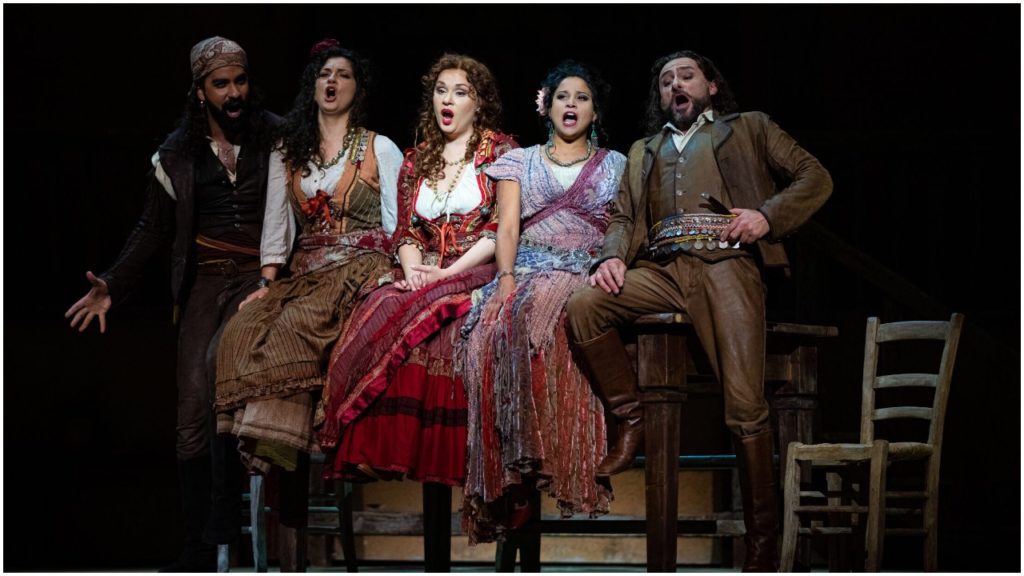
(Photo credit: Khalid AlBusaidi / ROHM)
Mesmerizing Ensembles
The chorus of the Teatro Colón was truly mesmerizing the entire evening, particularly in the fourth Act where the combined voices were a tidal wave of effervescent sound. There was a lot of joy and excitement emanating from the chorus in this section.
The orchestra was also having quite a fine evening, delivering one of the most energized and nuanced performances of “Carmen” that I have heard in a while. All the notes were the right place and under maestro Antonello Allemandi, everyone seemed to be taking the same breath both on and offstage. His only miscalculation was in the balance of the big ensembles. In solo passages and duets, he managed to keep the singers at the forefront. But in larger ensembles, the orchestra would always swallow up whatever sound came from behind.
It is worth mentioning Christian Peregrino’s Zuñiga, Stacey Alleaume’s Frasquita, Laura Verrecchia’s Mercédès, Gustavo Feulien’s Dancaïre, and Sergio Spina’s Remendado for their involved portrayals. Peregrino was robust in his vocal interventions and matched Cura’s José during their intense duels. Alleaume’s high notes were pristine every time she unleashed them. Verrecchia, Spina, and Feulien were all solid in their respective ensembles.
On the whole, this was an exciting series of performances that served as a sharp reminder of the ever-changing nature of theater and the freedom of exploration that a smart director can allow his thespians. This production was, on paper, as traditional as they come. And yet, the artists found ways to create unique interpretations of the same work and context on different nights.


